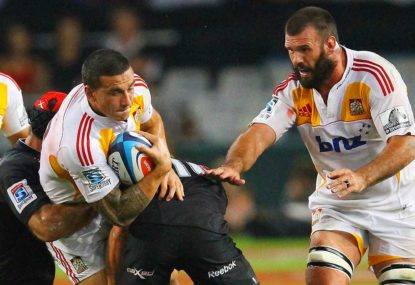The greatest improvement of all in the professional rugby game compared to the amateur days is in defence.
Readers of a certain age will remember rugby being scoffed at by their league counterparts, saying that rugby players couldn’t tackle. In most cases they were right, at least not the sort of tackling that went on in rugby league – crunching, front-on hits on big men at full pace.
How things have changed. The legal crash tackle is one of the features of Super Rugby. Remember Ben Tameifuna’s bone rattler on Michael Hooper last season? That’s just one of several whacks that happen each week.
The old days of busting up a defence by straight-out hard running aren’t entirely gone (witness inroads made by Jacques Potgieter for the Waratahs and Tevita Kuridrani for the Brumbies), but the opportunities are definitely limited. Even the Rebels, whose defence once made them relative easy-beats, have shown that tries against them in 2015 will be hard earned.
To combat this, the top teams are focusing in hard on one key skill – the offload in contact.
The offload in a tackle creates space by taking out a defender and then putting a close running receiver in behind the advantage line. As long as the ball is moving around in front of the line, a fit, well-organised defence can control a game relatively well, even without the ball. But as soon as attackers get in behind, the defensive line is out of the game. Cue a scramble.
It’s no coincidence that the Super Rugby teams who are good at the offload are the teams that are winning – the Chiefs and the Hurricanes particularly. But it’s not just this year – the trend was clearly building last year and was evident in the Waratahs style – in fact they were the top offloading team in their inaugural title year.
In 2014, five out of the top six offloading teams made the finals. This year it is a bit early to get a clear trend, but so far the top six offloading teams include half of the top six on the table plus last year’s two finalists. So it certainly appears as though the offload is a big part of success.
Sonny Bill Williams is the obvious weapon for the Chiefs, and his Hurricanes counterpart Ma’a Nonu has also made the offload an art form. But it’s not only size and power that equips a player to position for the offload – footwork counts as well, which accounts for Kurtley Beale and Matt Toomua figuring high up the competition offload stats. The Blues’ Patrick Tuilpolotu and the Chiefs’ Charlie Ngati also rank highly.
Also interesting is that the competition benchmark Chiefs have four out of the top ten offloaders in the competition, while no other team has more than one – testament to the Chiefs’ high-octane rugby.
Of course, the offload is not a game plan in itself. Instead, it is a game breaker between two fairly evenly matched teams. Watch any set of match highlights and it quickly becomes evident that almost all tries originate from one of three sources – set-play deception, counter attack from a turnover, or continuity from the offload. Of the three, the offload demands the most skill.
All teams practice set plays and most professionals can catch and pass well enough to execute a set manoeuvre, so it is essential but not a differentiator.
Counter attack is almost always against a fragmented defensive line and gives space for players to run and pass, so again most teams will have some success there.
The offload however, demands precise timing during contact, often from more than one tackler. It also demands that other players work off the ball to position well enough to take the pass. Not every team can do it, and fewer can do it well.
In last week’s matches, the Blues and Cheetahs both benefited from offload tries. Jerome Kaino virtually fell over from one metre out, when his inside men committed players and offloaded successfully. Teammate Charlie Faumuina rumbled over from five metres after Patrick Tuipolotu committed two defenders and offloaded.
For the Cheetahs, Cornel Hendricks offloaded to a teammate and then after two further offloads, eventually received the pass back to score the try. As is a requirement with the offload, the three players were eager to keep the ball alive and put themselves in position to take the pass, otherwise the try would certainly not have been scored.
In the Chiefs vs Crusaders game, Sonny Bill Williams’ try was set up by two brilliant pieces of passing-in-contact – first a magnificent flick out of the back of the hand by Johan Bardoul to a flying Charlie Ngatai, who then popped a marvellous pass off the ground to continue the movement. Williams was the eventual beneficiary, scoring from two metres out.
In the Sharks vs Bulls match, Ryan Kanowski scored after Renaldo Bothma singlehandedly battled through two tacklers and slipped a sleight-of-hand pass to his wing, allowing the Sharks to slice up the defence and give Kankowski a clear run.
As with most good offloads, once the support player is clear, there is little the defence can do.
While the tries in Super Rugby still often come from set piece and counter, the offload is the special sauce against a good defence – the factor that separates the true contenders from the hopefuls.
And with four out of the top ten offloaders in the competition, the Chiefs look to be just a little more special than the rest.





























































































